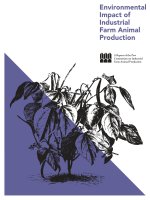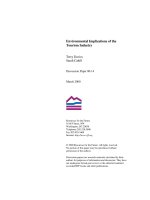Environmental Impact of Biofuels Part 5 pdf
Bạn đang xem bản rút gọn của tài liệu. Xem và tải ngay bản đầy đủ của tài liệu tại đây (4.18 MB, 20 trang )
Environmental Impact of Biofuels
72
0
10
20
30
40
1000 1500 2000 2500
rpm
smoke%
diesel
u5
u10
u20
u30
u40
u50
Fig. 5. The smoke variation on different rpm regarding to the mixture
2.2 Maize oil
In the experiment stage has been used directly maize oil in the mixture of diesel in to a four
– stroke diesel engine. Specifically it has been used diesel, mixture diesel-5% maize oil (k5),
diesel-10% maize oil (k10), diesel-20% maize oil (k20), diesel-30% maize oil (k30), diesel-40%
maize oil (k40), diesel-50% maize oil (k50) in a four-stroke diesel engine [17]:
CO %
rpm
diesel k5 k10 k20 k30 k40 k50
1000
0,0289 0,0310 0,0309 0,0309 0,0319 0,0397 0,0345
1500
0,0303 0,0302 0,0304 0,0311 0,0345 0,0211 0,0288
2000
0,01 0,0280 0,0232 0,0284 0,0274 0,0281 0,0219
2500
0,0350 0,0244 0,0317 0,0296 0,0324 0,0305 0,0292
Table 5. The CO average value variation on different rpm regarding to the mixture
HC (ppm)
rpm
diesel k5 k10 k20 k30 k40 k50
1000
2,535 14,937 6,244 10,326 3,406 5,358 9,167
1500
13,31 21,485 9,236 17,997 14,718 0,449 17,197
2000
7,131 3,184 13,970 15,965 8,402 8,502 12,913
2500
10,961 16,347 18,884 23,556 30,551 7,451 17,712
Table 6. The HC average value variation on different rpm regarding to the mixture
Emissions of Diesel - Vegetable Oils Mixtures
73
NO (ppm)
rpm
diesel k5 k10 k20 k30 k40 k50
1000
518,210 771,001 696,827 495,603 380,361 349,140 207,760
1500
739,366 754,126 913,037 771,607 723,381 872,06 582,908
2000
762,155 834,334 520,485 760,936 839,268 928,337 720,505
2500
795,461 946,349 518,287 710,402 864,585 674,432 847,835
Table 7. The NO average value variation on different rpm regarding to the mixture
% smoke
rpm
diesel k5 k10 k20 k30 k40 k50
1000
3,262 12,722 7,301 7,488 16,623 7,200 26,232
1500
7,100 10,924 5,487 6,547 14,850 12,141 24,035
2000
5,688 18,679 4,001 6,588 9,936 14,071 18,884
2500
29,006 28,282 21,848 15,730 17,579 13,438 14,265
Table 8. The % smoke average value variation on different rpm regarding to the mixture
0
0,01
0,02
0,03
0,04
0,05
0,06
0,07
0,08
1000 1500 2000 2500
rpm
co%
diesel
k5
k10
k20
k30
k40
k50
Fig. 6. The CO variation on different rpm regarding to the mixture
Environmental Impact of Biofuels
74
0
10
20
30
40
1000 1500 2000 2500
rpm
HC(ppm)
diesel
k5
k10
k20
k30
k40
k50
Fig. 7. The HC variation on different rpm regarding to the mixture
0
100
200
300
400
500
600
700
800
900
1000
1000 1500 2000 2500
rpm
NO(ppm)
diesel
k5
k10
k20
k30
k40
k50
Fig. 8. The NO variation on different rpm regarding to the mixture
Emissions of Diesel - Vegetable Oils Mixtures
75
%smoke
0
10
20
30
40
1000 1500 2000 2500
rpm
smoke%
diesel
k5
k10
k20
k30
k40
k50
Fig. 9. The smoke variation on different rpm regarding to the mixture
From figure 6 it is clear that when the maize oil is increased on the fuel regarding to diesel, it
appears an increase of CO, except in the case k40/1500rpm. From figure 7 it can be noticed
the biggest reduction of HC regarding to diesel in case of k40/1500rpm. From figure 8 it can
be noticed the biggest reduction of NO regarding to diesel in the case of k20/2000-2500rpm.
From figure 9 it can be noticed the biggest reduction for k10/1500-2000rpm. From the above
figures it is clear that the use of different mixtures can constitute changes to CO, HC, NO
and smoke too. It is also important the fact that there was no changes in the rounds of the
engine, as well as in the supply of water at the use of mixtures. Finally as far as the
consumption is concerned, did not observed changes with the use of different mixtures. The
use of mixture of diesel and maize oil has the following impacts:
- About CO it can be noticed that when the maize oil is increased on the fuel regarding to
diesel, it appears a decrease of CO, except in the case k40/1500rpm.
- About HC it can be noticed the biggest reduction of HC regarding to diesel in case of
k40/1500rpm
- The biggest reduction of NO regarding to Diesel is noticed in the case of k20/2000-
2500rpm.
- The smoke it can be noticed the biggest reduction for k10/1500-2000rpm
2.3 Cotton oil
In the experiment stage has been used directly cotton oil in the mixture of diesel in to a four
– stroke Diesel engine and not elaborated in the figure of bio-diesel. Specifically it has been
used diesel, mixture diesel- 10% cotton oil(B10), diesel- 20% cotton oil(B20), diesel- 30%
cotton oil (B30), diesel- 40% cotton oil (B40), diesel- 50% cotton oil (B50) in a four-stroke
diesel engine [18]:
Environmental Impact of Biofuels
76
The experimental results are shown at the following tables and figures:
0,05
0,06
0,07
0,08
0,09
0,1
1000 1500 2000 2500
rpm
%CO
Dies el
B10%
B20%
B30%
B40%
B50%
Fig. 10. The CO variation on different rpm regarding to the mixture
From figure 10 it is clear that when the cotton oil is increased on the fuel regarding to Diesel,
it appears an increasement of CO.
% CO
rpm
Diesel Β10 Β20 Β30 Β40 Β50
1000 0,075 0,076 0,075 0,091 0,098 0,095
1500 0,063 0,064 0,066 0,069 0,075 0,077
2000 0,052 0,057 0,062 0,057 0,065 0,061
2500 0,057 0,058 0,056 0,062 0,064 0,065
Τable 9. The CO average value variation on different rpm regarding to the mixture
HC (ppm)
rpm
Diesel Β10 Β20 Β30 Β40 Β50
1000 30,78 35,86 39,04 39,05 14,86 46,64
1500 62,86 41,18 35,59 48,74 53,84 51,34
2000 125,52 83,84 101,38 109,07 76,42 142,94
2500 78,26 84,93 169,34 103,64 167,82 105,80
Table 10. The HC average value variation on different rpm regarding to the mixture
Emissions of Diesel - Vegetable Oils Mixtures
77
NO (ppm)
rpm
Diesel Β10 Β20 Β30 Β40 Β50
1000 439,67 471,17 464,34 361,59 318,85 320,47
1500 649,65 660,83 626,78 611,71 565,26 522,16
2000 710,41 688,75 679,64 687,06 710,18 798,96
2500 868,88 930,50 919,53 919,08 987,35 947,80
Table 11. The no average value variation on different rpm regarding to the mixture
%smoke
rpm
Diesel Β10 Β20 Β30 Β40 Β50
1000 7,72 5,76 6,36 13,89 12,88 13,35
1500 5,81 3,16 5,41 10,72 12,17 13,62
2000 5,24 3,62 4,45 7,59 7,28 7,70
2500 10,98 7,94 9,93 7,92 9,62 9,01
Table 12. The %smoke average value variation on different rpm regarding to the mixture
0
20
40
60
80
100
120
140
160
180
1000 1500 2000 2500
rpm
HC(ppm)
Diesel
B10%
B20%
B30%
B40%
B50%
Fig. 11. The HC variation on different rpm regarding to the mixture
From figure 11 it can be noticed the biggest reduction of HC regarding to Diesel in case of
the mixture B20/1500 rpm and in the case of the mixture B40/2000 rpm.
From figure 12 it can be noticed the biggest reduction of NO regarding to Diesel in the cases
of the mixture B40/1000 rpm, B50/1000 rpm and B50/1500 rpm too.
From figure 13 it can be seen the reduction of smoke regarding to Diesel in case of the
mixture B10 and B20 at all rounds per minute. It can also be noticed the reduction of smoke
in the case of B30, B40, B50/2500 rpm. Finally it can be seen an increasement of the mixture
B30, B40, B50 at all rounds regarding to Diesel. From the above figures it is clear that the use
of different mixtures can constitute changes to CO, HC, NO and smoke too.
Environmental Impact of Biofuels
78
200
400
600
800
1000
1000 1500 2000 2500
rpm
NO(ppm)
Diesel
B10%
B20%
B30%
B40%
B50%
Fig. 12. The NO variation on different rpm regarding to the mixture
2
4
6
8
10
12
14
1000 1500 2000 2500
rpm
%smok
e
Diesel
B10%
B20%
B30%
B40%
B50%
Fig. 13. The smoke variation on different rpm regarding to the mixture
It is also important the fact that there was no changes in the turns of engine, as well as in the
supply of water at the use of mixtures. Finally as far as the consumption is concerned, did
not exist changes with the use of different mixtures.The use of mixture of Diesel and Cotton
Oil has the following impacts:
- About CO it can be noticed an increasement when the cotton oil is used as a fuel.
- About HC it can be noticed a reduction at 1500 rpm and particularly bigger reduction in
the use of B20. It also appears reduction of the HC for all the mixture at 2000 rpm with
the exception of B50. Finally about the HC, for all the mixture at 2500 rpm is observed
increase of HC regarding to Diesel.
- About NO has been noticed a reduction at 1000 rpm and 1500 rpm for all the mixtures.
A small reduction appeared for all the mixtures at 2500 rpm with the exception of B50,
regarding to Diesel. Finally about the NO for all the mixtures appeared increase at 2500
rpm regarding to Diesel.
Emissions of Diesel - Vegetable Oils Mixtures
79
- About the smoke it can be noticed a reduction of the mixture of B20 and B10, but it
appears an increasement for all other mixture in any round regarding to Diesel, with
the exception of 2500 rpm, in where all the mixture appear a reduction.
2.4 Olive seed oil
In the experiment stage has been used directly cotton oil in the mixture of diesel in to a four
– stroke Diesel engine. Specifically it has been used diesel, mixture diesel-5% olive seed oil
(Pyrin5%), diesel-10% olive seed oil (Pyrin10%), diesel-20% olive seed oil (Pyrin20%), diesel-
30% olive seed oil (Pyrin30%), diesel-40% olive seed oil (Pyrin40%), diesel-50% olive seed oil
(Pyrin50%) in a four-stroke diesel engine [19]:
The experimental results are shown at the following tables and figures:
CO %
rpm
diesel
Pyrin
5%
Pyrin
10%
Pyrin
20%
Pyrin
30%
Pyrin
40%
Pyrin
50%
1000
0,056 0,056 0,054 0,060 0,053 0,053 0,048
1500
0,055 0,044 0,038 0,055 0,040 0,041 0,036
2000
0,043 0,038 0,031 0,050 0,031 0,036 0,030
Table 13. The CO average value variation on different rpm regarding to the mixture
HC (ppm)
rpm
diesel
Pyrin
5%
Pyrin
10%
Pyrin
20%
Pyrin
30%
Pyrin
40%
Pyrin
50%
1000
31,783 35,237 77,922 152,830 13,023 16,799 12,508
1500
38,001 48,434 79,198 165,479 22,954 24,870 22,860
2000
38,338 71,585 97,513 208,166 60,209 37,725 47
Table 14. The HC average value variation on different rpm regarding to the mixture
NO (ppm)
rpm diesel
Pyrin
5%
Pyrin
10%
Pyrin
20%
Pyrin
30%
Pyrin
40%
Pyrin
50%
1000
518,210 415,212 375,075 392,478 372,681 473,620 362,663
1500
739,366 730,361 677,793 703,549 673,198 729,462 758,413
2000
762,155 790,676 738,929 805,702 825,376 938,210 880,990
Table 15. The NO average value variation on different rpm regarding to the mixture
%smoke
rpm
diesel Pyrin 5% Pyrin 10% Pyrin 20% Pyrin 30% Pyrin 40% Pyrin 50%
1000
9,990 12,605 14,787 12,717 11,018 9,932 16,278
1500
7,363 11,967 10,594 13,715 12,575 13,285 19,673
2000
6,634 14,212 12,201 14,131 14,098 17,528 23,359
Table 16. The %smoke average value variation on different rpm regarding to the mixture
Environmental Impact of Biofuels
80
0,02
0,025
0,03
0,035
0,04
0,045
0,05
0,055
0,06
0,065
1000 1500 2000
rpm
CO %
Diesel
Pyrin 5%
Pyrin 10%
Pyrin 20%
Pyrin 30%
Pyrin 40%
Pyrin 50%
Fig. 14. The CO variation on different rpm regarding to the mixture
0
50
100
150
200
250
1000 1500 2000
rpm
HC ppm
Diesel
Pyrin 5%
Pyrin 10%
Pyrin 20%
Pyrin 30%
Pyrin 40%
Pyrin 50%
Fig. 15. The HC variation on different rpm regarding to the mixture
Emissions of Diesel - Vegetable Oils Mixtures
81
0
200
400
600
800
1000
1200
1000 1500 2000
rpm
NO ppm
Diesel
Pyrin 5%
Pyrin 10%
Pyrin 20%
Pyrin 30%
Pyrin 40%
Pyrin 50%
Fig. 16. The NO variation on different rpm regarding to the mixture
0
5
10
15
20
25
1000 1500 2000
rpm
smoke %
Diesel
Pyrin 5%
Pyrin 10%
Pyrin 20%
Pyrin 30%
Pyrin 40%
Pyrin 50%
Fig. 17. The smoke variation on different rpm regarding to the mixture
From figure 14 it is clear that when the olive seed oil is increased on the fuel regarding to
diesel, it appears a decrease of CO. From figure 15 it can be noticed the biggest reduction of
HC regarding to diesel in case of pyrin50%. From figure 16 it can be noticed the biggest
Environmental Impact of Biofuels
82
reduction of NO regarding to diesel in the case of pyrin10%/2000rpm. From figure 17 it can
be noticed that the best behaviour appears on diesel. From the above figures it is clear that
the use of different mixtures can constitute changes to CO, HC, NO and smoke too. It is also
important the fact that there was no changes in the rounds of the engine, as well as in the
supply of water at the use of mixtures. Finally as far as the consumption is concerned, did
not observed changes with the use of different mixtures. The use of mixture of diesel and
olive seed oil has the following impacts:
- About CO it can be noticed when the olive seed oil is increased on the fuel regarding to
diesel, it appears a decrease of CO
- About HC it can be noticed the biggest reduction of HC regarding to diesel in case of
pyrin50%
- The biggest reduction of NO regarding to diesel in the case of pyrin10%/2000rpm.
- The smoke it can be noticed that the best behaviour appears on diesel.
2.5 Soy oil
In the experiment stage has been used directly soy oil in the mixture of diesel in to a four –
stroke Diesel engine. Specifically it has been used Diesel, mixture Diesel-5% soy oil (S5),
Diesel-10% soy oil (S10), Diesel-20% soy oil (S20), Diesel-30% soy oil (S30), Diesel-40% soy
oil (S40), Diesel-50% soy oil (S50) in a four-stroke diesel engine [20]:
The experimental results are shown at the following tables and figures:
0,02
0,03
0,04
0,05
0,06
0,07
0,08
1000 1500 2000
rpm
CO %
Diesel
S 5%
S 10%
S 20%
S 30%
S 40%
S 50%
Fig. 18. The CO variation on different rpm regarding to the mixture
From figure 18 it is clear that when the soy oil is increased on the fuel regarding to diesel, it
appears a decrease of CO, except in the cases S5,30,40,50/1000rpm.
Emissions of Diesel - Vegetable Oils Mixtures
83
HC (ppm)
rpm
Diesel S5 S10 S20 S30 S40 S50
1000 31,78 21,15 21,88 8,28 5,76 54,61 28,01
1500 38,00 24,30 51,65 9,16 5,80 55,53 30,04
2000 38,33 23,70 89,90 28,68 22,34 84,88 67,47
Table 17. The CO average value variation on different rpm regarding to the mixture
NO (ppm)
rpm
Diesel S5 S10 S20 S30 S40 S50
1000 454,2 387,6 397,5 416,1 414,8 341,0 277,9
1500 715,3 739,8 743,6 720,9 758,8 718,8 651,1
2000 1109,6 621,7 829,6 808,2 915,6 919,8 920,2
Table 18. The HC average value variation on different rpm regarding to the mixture
% smoke
rpm
Diesel S5 S10 S20 S30 S40 S50
1000 9,99 8,72 9,41 11,61 14,26 18,32 24
1500 7,36 8,23 8,43 9,87 13,02 18,21 17,84
2000 6,63 6,25 7,70 8,08 11,27 17,21 20,5
Table 19. The NO average value variation on different rpm regarding to the mixture
CO %
rpm
Diesel S5 S10 S20 S30 S40 S50
1000 0,056 0,063 0,056 0,052 0,062 0,069 0,072
1500 0,055 0,053 0,043 0,041 0,045 0,049 0,042
2000 0,043 0,044 0,037 0,04 0,032 0,037 0,029
Table 20. The %smoke average value variation on different rpm regarding to the mixture
200
300
400
500
600
700
800
900
1000
1100
1200
1000 1500 2000
rpm
NO ppm
Diesel
S 5%
S 10%
S 20%
S 30%
S 40%
S 50%
Fig. 19. The HC variation on different rpm regarding to the mixture
Environmental Impact of Biofuels
84
From figure 19 it can be noticed the biggest reduction of HC regarding to diesel in case of
the mixtures S5, S20 and the mixture S40.
200
300
400
500
600
700
800
900
1000
1100
1200
1000 1500 2000
rpm
NO pp
m
Diesel
S 5%
S 10%
S 20%
S 30%
S 40%
S 50%
Fig. 20. The NO variation on different rpm regarding to the mixture
From figure 20 it can be noticed the biggest reduction of NO regarding to Diesel in the case
of the mixture S50.
5
7
9
11
13
15
17
19
21
23
25
1000 1500 2000
rpm
smoke %
Diesel
S 5%
S 10%
S 20%
S 30%
S 40%
S 50%
Fig. 21. The smoke variation on different rpm regarding to the mixture
From figure 21 it can be seen the increase of smoke regarding to diesel for all the mixtures.
From the above figures it is clear that the use of different mixtures can constitute changes to
CO, HC, NO and smoke too. It is also important the fact that there was no changes in the
Emissions of Diesel - Vegetable Oils Mixtures
85
rounds of the engine, as well as in the supply of water at the use of mixtures. Finally as far
as the consumption is concerned, did not observed changes with the use of different
mixtures. The use of mixture of diesel and soy oil has the following impacts:
- About CO it can be noticed that when the soy oil is increased on the fuel regarding to
diesel, it appears a decrease of CO, except in the cases S5,30,40,50/1000rpm.
- About HC it can be noticed the biggest reduction of HC regarding to diesel in case of
the mixtures S5, S20 and the mixture S40.In the case of S30 appears the maximum
increase of HC in relation to diesel.
- The biggest reduction of NO regarding to Diesel is noticed in the case of the mixture
S50.
- The smoke is increased regarding to diesel for all the mixtures. Except the cases
S5,50/1000rpm.
3. References
[1] Aldritton L, Monastersky R., Eddy A, Hall M, Shea E. (1992). Our Ozone Shield Reports to
the Nation on Our Changing Planet. Fall 1992, University Cooperation for
Atmospheric research office for interdisciplinary studies Boulder, Colorado.
[2] Arapatsakos C, (2000). Air and water influence of two stroke outboard engine using
gasoline - ethanol mixtures, Transaction of SAE, Book SP-1565.
[3] Arapatsakos C, Karkanis A, Sparis P. Environmental Contribution of Gasoline- Ethanol
Mixtures, WSEAS Transactions on Environment and Development, Issue 7, Volume 2,
July 2006.
[4] Arapatsakos C, Karkanis A, Sparis P. Gas emissions and engine behavior when gasoline-
alcohols mixtures are used, Journal of Environmental Technology, Vol. 24, pp. 1069-
1077.
[5] Arapatsakos C. Testing the tractor engine using diesel – ethanol mixtures under full load
conditions, International Journal of Heat & Technology, Vol. 19, n.1, 2001.
[6] Arapatsakos C, Christoforidis D, Karkanis A. The gas emissions variation of diesel
engine from the combustion of used vegetable oils, Proceedings of International
Conference on Energy and Environment, Cambridge 2009.
[7] Arapatsakos C., Christoforidis D, Karkanis A, Mitroulas D, Teka C. (2007). Test results
from the use of cotton oil mixtures as fuel in a four-stroke engine, International
journal of Energy and Environment, Issue3 Vol. 1, 2007.
[8] Arapatsakos C, Christoforidis D, Karkanis A, Mitroulas D. Fuel of diesel – olive seed oil
mixture΄ International journal of energy Issue 3 vol 2, 2008.
[9] Arapatsakos C, Christoforidis D, Karkanis A, Mitroulas K. Soy oil as fuel in a four stroke
engine, Journal of wseas transactions on environment and development 2008.
[10] Arapatsakos C, Christoforidis D, Sarantitis G, Giannopoulos D. Fuel mixtures of diesel-
maize oil International journal of energy Issue 3 vol 2, 2008
[11] Schafer F., Basshuysen R. V., (1995). Reduced Emissions and Fuel Consumption in
Automobile Engines Published by SAE.
[12] Menrad H, Haselhorst M. Alcohol fuels, Monograph. Springer, New York, ISBN
3211816968, 1981.
[13] Harrington A.; Shishu C. A Single-Cylinder Engine Study of the Effects of Fuel Type,
Fuel Stoichiometry and Hydrogen-to-Carbon Ratio on CO, NO and HC Exhaust
Emissions, SAE-Paper 730476
Environmental Impact of Biofuels
86
[14] Owen K, Coley T, (1995). Automotive Fuels Reference Book, (Second Edition),
Published by SAE.
[15] Mitchell B. (1989) .The greenhouse effect and climate change. Reviews of Geophysics 27.
[16] Arapatsakos C, Karkanis A, Sparis P, Gas emissions and engine behaviour when
gasoline –alcohol mixtures are used, Environmental technology 24 (2003) 1069-1077.
[17] Siddharth S., Green Energy-Anaerobic Digestion. Converting Waste to Electricity,
WSEAS Transactions on Environment and Development, Issue 7, Volume 2, July 2006.
[18] Swedish Motor Fuel Technology Co., Alcohols and alcohol blends as motor fuels, Vol. II B,
p.8:39, STU information No 580,1986.
[19] Maxwell T, Jones C, (1995). Alternative fuels: Emissions, Economics and Performance
Published by SAE.
[20] Schenewerk E, Automatic DRAC LMFBR to Speed Licensing and Mitigate CO2, WSEAS
Transactions on Environment and Development, Issue 7, Volume 2, July 2006.
5
Biofuels and Ecosystem Carbon Balance
Under Global Change
Christina Schädel and Yiqi Luo
Department of Botany and Microbiology, University of Oklahoma
USA
1. Introduction
Terrestrial ecosystems are estimated to contain 3000 Pg of organic carbon (C) of which more
than two thirds are stored in soils (Jobbágy and Jackson 2000). Total soil organic carbon
(SOC) consists of different C pools with intrinsic turnover rates ranging from less than a
year to thousands of years (Amundson 2001). The processes that drive the cycling of soil C
are C inputs from net primary productivity (NPP=GPP-ecosystem respiration) and outputs
through C decomposition (Fig. 1). New organic matter is the product of NPP which is
transferred to soils in the form of litter and presents the largest C input to soils. Carbon
output to the atmosphere is mainly driven by soil respiration (consisting of autotrophic and
heterotrophic respiration) which is the second largest driver of C in the global C cycle (Fig.
1). Annually, soils release 98 ± 12 Pg C to the atmosphere which has increased yearly by 0.1
Pg C between 1989-2008 (Bond-Lamberty and Thomson 2010) and which yearly exceeds the
current rate of fossil fuel combustion by a factor of 10. These large numbers show that even
slight changes in the soil C and soil C cycling are highly relevant to the global C cycle
mainly because of their potential to sequester or release CO
2
(Trumbore 1997). C
sequestration denotes the transfer of C from atmospheric CO
2
into long-lived pools (e.g.
woody biomass, recalcitrant soil C pools) without reemitting it immediately.
Although the soil is a dynamic system C input and output need to be balanced in order to
keep the SOC pool at equilibrium (Fig. 2a). If C input is smaller than C output a depletion of
the SOC pool occurs which can result in large releases of CO
2
to the atmosphere (Fig. 2b).
On the other hand, if C input to the soil exceeds C output additional SOC can be sequestered
in soils. SOC is not only an important C sink within the terrestrial C budget it also strongly
influences soil fertility and soil quality which in return is needed for plant growth (Lal 2004;
Cruse et al. 2010).
Global change denotes all human-caused changes to the atmosphere, hydrosphere,
pedosphere and biosphere (Körner 2003). The increasing CO
2
concentration in the
atmosphere is one of the most drastic global change components that directly affect plants
and the ecosystems they live in (IPCC 2007). Secondary effects of higher CO
2
concentrations
are climate warming causing tertiary effects such as extended growing seasons, shifts in
species composition and alterations in precipitation patterns. Elevated CO
2
directly affects
plants through photosynthesis and as photosynthesis at the current level of CO
2
concentration is not yet CO
2
-saturated there is leeway for more carbon fixation and with it
the possibility of more C storage in terrestrial ecosystems. On the other hand climate
Environmental Impact of Biofuels
88
warming affects almost all aspects of carbon cycling and enhanced C fluxes potentially feed
back to the atmosphere causing the so called positive feedback to climate change (Luo 2007).
growth
SOM
Atmos
p
heric CO
2
Root exudates
Photosynthesis
GPP
Litterfall
Autotrophic
respiration
Heterotrophic
respiration
Ecosystem
respiration (ER)
Fig. 1. Schematic diagram of terrestrial ecosystem C processes. GPP, gross primary
production, SOM, soil organic matter
Identifying possible strategies for mitigating climate change by reducing increases in
atmospheric CO
2
has put a strong focus on growing biofuel feedstock for alternative energy.
Biofuels are generated through the combustion of biomass, usually grain or cellulosic-based
feedstock. Biofuel feedstock production can help offset C emissions from fossil fuels but
continuous biomass harvesting involves the removal of large quantities of C inducing a
disequilibrium in the ecosystem’s C balance (Fig. 2b; Luo and Weng 2011). There is thus an
urgent need to investigate the impacts of biofuel feedstock harvesting on an ecosystem’s C
balance and its feedback to climate change (Luo et al. 2009)
This chapter focuses on key issues related to biofuel feedstock harvesting and ecosystem C
balance under global change.
2. Terrestrial ecosystem C cycle
Carbon enters a terrestrial ecosystem through photosynthetic uptake (GPP=gross primary
production) and is either incorporated into biomass, respired through ecosystem respiration
(ER=autotrophic + heterotrophic respiration) or secreted into the soil via litter and root
exudates (Fig. 1; Chapin et al. 2009). The main terrestrial ecosystem C cycling processes are
photosynthesis and C decomposition and hence are the main components to calculate net
ecosystem productivity (NEP=GPP-ER). Once C has entered the plant system it is allocated
to above- and belowground tissues with the partitioning being strongly dependent on
nutrient availability. The partitioning of C allocation within the plant influences how much
C goes into aboveground biomass (leaves, stems) and how much enters the soil (coarse and
Biofuels and Ecosystem Carbon Balance Under Global Change
89
fine roots). Belowground primary productivity can account for up to 33% of the annual net
primary productivity (Jackson et al. 1997; Norby et al. 2004) which assigns roots an
important role in the net ecosystem C balance. Dead plant material from above- and
belowground litter is decomposed by microorganisms releasing CO
2
to the atmosphere and
providing energy for microbial biomass growth. Microbial biomass together with organic
residuals of dead plant material and dead microbes form the soil organic matter (SOM, Luo
and Zhou 2006) of which carbon represents 50% by weight. C decomposition from short-
and long-lived C pools is one of the most important factors in regulating terrestrial
ecosystem C cycles.
CO
2
CO
2
SOC
C input = C output
a
SOC
C input < C output
b
CO
2
CO
2
Fig. 2. Soil C dynamics for a) a natural grassland and b) a harvested field for biofuel
feedstock. Red arrows represent C input to the soil and black arrows C output
3. Global change and C processes
Global change is one of the most important issues that this century is going to face. Global
atmospheric CO
2
concentrations gradually increased from pre-industrial concentrations of
280 ppm to 390 ppm in 2011 (Mauna Loa, Hawaii; Tans 2011) and continue to increase, the
main causes being deforestation, land use change and the burning of fossil-fuels (IPCC
2007). As a consequence to the increasing CO
2
and other green house gas concentrations in
the atmosphere, global temperatures have increased by 0.74°C over the last century and
predictions for the end of this century suggest a further increase in temperatures by another
1.1°C - 6.4°C (IPCC 2007). Temperature affects almost all chemical and biological processes
(Shaver et al. 2000) and increasing global temperatures will likely enhance C fluxes between
pools. As primary productivity and C decomposition are directly affected by changes in
temperature ecosystem C uptake will be highly influenced by global warming. One of the
major uncertainties of global warming is a possible positive feedback between the global
carbon cycle and climate change but interactions among processes and fluxes are most
uncertain making predictions difficult (Shaver et al. 2000; Luo 2007). Global change also
includes altered precipitation regimes as a direct result to climate warming with a higher
frequency in extreme events (rainfall extreme, drought) being very likely (IPCC 2007).
Furthermore, human activities have increased the rate and magnitude of N deposition
(Galloway et al. 2004) and since N availability strongly influence C processes future
Environmental Impact of Biofuels
90
ecosystem C sequestration largely depends on N availability (Luo et al. 2004; Luo et al. 2006;
Field et al. 2007). Global change includes various factors and their multiple interactions have
smaller or larger impacts on ecosystem C processes and understanding those interactive
effects on ecosystem processes becomes crucial in predicting possible carbon-climate
feedbacks (Luo et al. 2008).
3.1 Impacts of global change on C processes
C influx through photosynthesis is stimulated by increased CO
2
concentrations (Curtis and
Wang 1998; Norby et al. 1999; Ainsworth and Long 2005) often leading to increasing
biomass growth but results are highly variable between species and plant age (Norby et al.
1999; Körner et al. 2005). Higher CO
2
concentrations could also induce higher C
sequestration in soils (Jastrow et al. 2005; Lichter et al. 2005) but results strongly varied with
CO
2
experimental facility, ecosystem type and N treatment (Luo et al. 2006). Highest C
sequestration rates in soils were found in studies with N fertilization (Hungate et al. 2009)
and most likely reflect effects of elevated CO
2
and N on plant growth as well as interactions
between CO
2
and N on soil C decomposition (Reich et al. 2006). Increased soil C efflux
under elevated CO
2
was reported from most CO
2
-enrichment studies which was attributed
to additional substrate from greater plant growth under elevated CO
2
available to soil
microorganisms (Zak et al. 2000).
Increasing temperatures affect most biochemical processes such as C influx and C
decomposition. Results are highly variable and range from no change, increases and
decreases in photosynthesis, plant growth, primary production and soil respiration (Luo
2007). Generally, C decomposition reacts more to higher temperatures (Melillo et al. 2002;
Zhou et al. 2007) than does C influx although the response of increasing soil C
decomposition to warming attenuates over time (Rustad et al. 2001). The overall response of
C decomposition to climate warming could be a net release of CO
2
from soils which might
result in a positive feedback between C cycles and climate warming within this century
(Friedlingstein et al. 2006). Furthermore, climate warming affects regulatory mechanisms of
ecosystem C processes such as increased length of growing season, changes in water
dynamics, species composition and nutrient availability (Luo 2007).
Precipitation patterns are changing in its frequency and intensity as a consequence of
climate warming. Increased precipitation mostly increases C uptake via photosynthesis as
well as increases soil respiration (Zhou et al. 2009). Drier conditions as they occur during
heat waves reduce gross primary productivity and result in large net releases of CO
2
(Ciais
et al. 2005; Arnone et al. 2008). This net release in CO
2
can offset C sequestration from
previous years and turn ecosystems into C sources which will then contribute to a positive
carbon-climate feedback. Besides the direct effects of increasing or decreasing water
availability there are indirect effects of water availability through other climate change
factors. Elevated CO
2
usually leads to less water loss through stomata (Medlyn et al. 2001;
Leuzinger and Körner 2007) whereas a warmer climate increases evaporation leading to
more negative water balances in the soil. As primary production in many ecosystems is
largely limited by water availability any changes in precipitation will have substantial
impacts on ecosystem C dynamics (Heimann and Reichstein 2008).
Nitrogen is one of the most limiting nutrients for plant growth (Vitousek and Howarth 1991)
and N fertilization is widely used to improve plant productivity. N addition can increase
plant growth by 30-50% although there are large differences between plant functional types
and biomes (LeBauer and Treseder 2008; Xia and Wan 2008). Interactions between C and N









